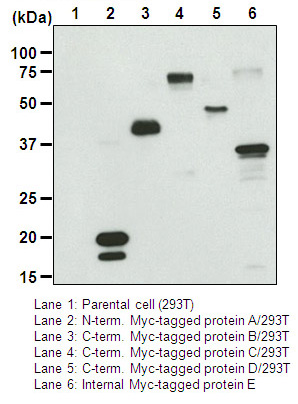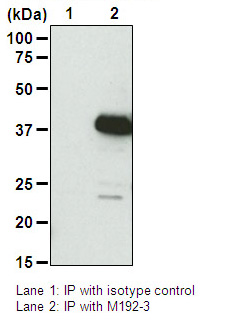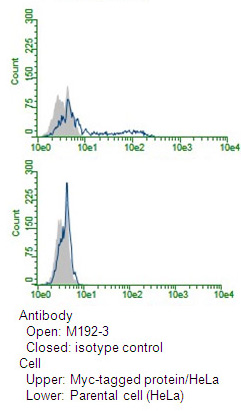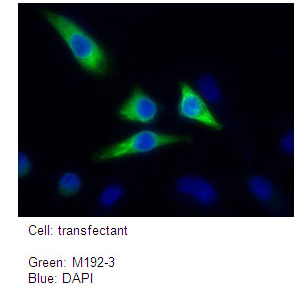| Citations |
Western Blotting - Horibata Y et al. Identification of the N-terminal transmembrane domain of StarD7 and its importance for mitochondrial outer membrane localization and phosphatidylcholine transfer. Sci Rep. 7, 8793 (2017)(PMID:28821867)
- Wang S et al. Inhibition of the deubiquitinase USP5 leads to c-Maf protein degradation and myeloma cell apoptosis. Cell Death Dis. 8, e3058 (2017)(PMID:28933784)
- Ueda T et al. GADD45 family proteins suppress JNK signaling by targeting MKK7. Arch Biochem Biophys. 635, 1-7 (2017)(PMID:29037961)
- Hu L et al. The Coiled-Coil and Nucleotide Binding Domains of BROWN PLANTHOPPER RESISTANCE14 Function in Signaling and Resistance against Planthopper in Rice. Plant Cell. 29, 3157-31 (2017)(PMID:29093216)
- Hamada N et al. KI MUNC18-1 gene abnormalities are involved in neurodevelopmental disorders through defective cortical architecture during brain development. Acta Neuropathol Commun. 5, 92 (2017)(PMID:29191246)
- Wu Y et al. Sec16A, a key protein in COPII vesicle formation, regulates the stability and localization of the novel ubiquitin ligase RNF183. PLoS One. 13, e0190407 (2018)(PMID:29300766)
- Tu R et al. USP49 participates in the DNA damage response by forming a positive feedback loop with p53. Cell Death Dis. 9, 553 (2018)(PMID:29748582)
- Deng T et al. Deubiquitylation and stabilization of p21 by USP11 is critical for cell-cycle progression and DNA damage responses. PNAS. 115, 4678-4683 (2018)(PMID:29666278)
- Murakami K et al. Olfactomedin-like protein OLFML1 inhibits Hippo signaling and mineralization in osteoblasts. Biochem Biophys Res Commun. 505, 419-425 (2018)(PMID:30266405)
- Zhang J et al. A meiosis-specific BRCA2 binding protein recruits recombinases to DNA double-strand breaks to ensure homologous recombination. Nat Commun. 10, 722 (2019)
(PMID:30760716)
- Cao J et al. RACK1 Promotes Self-Renewal and Chemoresistance of Cancer Stem Cells in Human Hepatocellular Carcinoma through Stabilizing Nanog. Theranostics. 9, 811-828 (2019)(PMID:30809310)
- Moon S et al. Asxl1 exerts an antiproliferative effect on mouse lung maturation via epigenetic repression of the E2f1-Nmyc axis. Cell Death Dis. 9 1118 (2018)(PMID:30389914)
- Xu G et al. Inducible LGALS3BP/90K activates antiviral innate immune responses by targeting TRAF6 and TRAF3 complex. PLoS Pathog. 15, e1008002 (2019)(PMID:31404116)
- Chen XH et al. Mebendazole elicits potent antimyeloma activity by inhibiting the USP5/c-Maf axis. Acta Pharmacol Sin. 40, 1568-1577 (2019)(PMID:31197245)
- Song KH et al. HSP90A Inhibition Promotes Anti-Tumor Immunity by Reversing Multi-Modal Resistance and Stem-Like Property of Immune-Refractory Tumors. Nat Commun. 11, 562 (2020)(PMID:31992715)
- Zhang J et al. The BRCA2-MEILB2-BRME1 complex governs meiotic recombination and impairs the mitotic BRCA2-RAD51 function in cancer cells. Nat Commun. 11, 2055 (2020)(PMID:32345962)
- Jang YG et al. Mislocalization of TORC1 to Lysosomes Caused by KIF11 Inhibition Leads to Aberrant TORC1 Activity. Mol Cells. 43, 705-717 (2020)
(PMID:32759469)
- Xu Y et al. Anti-bacterial and anti-viral nanchangmycin displays anti-myeloma activity by targeting Otub1 and c-Maf. Cell Death Dis. 11, 818 (2020)
(PMID:32999280)
- Inagaki H et al. Direct evidence that Ataxin-2 is a translational activator mediating cytoplasmic polyadenylation. J Biol Chem. 295, 15810-15825 (2020)(PMID:32989052)
- He T et al. Duck enteritis virus pUL47, as a late structural protein localized in the nucleus, mainly depends on residues 40 to 50 and 768 to 777 and inhibits IFN-β signalling by interacting with STAT1. Vet Res. 51, 135 (2020)
(PMID:33176874)
ChIP - Chi Y et al. Loss of runx1 function results in B cell immunodeficiency but not T cell in adult zebrafish. Open Biol. 8, 180043 (2018)(PMID:30045885)
Co-IP - Habata S et al. BAG3-mediated Mcl-1 stabilization contributes to drug resistance via interaction with USP9X in ovarian cancer. Int J Oncol. 49, 402-10 (2016)(PMID:27120977)
- Hu L et al. The Coiled-Coil and Nucleotide Binding Domains of BROWN PLANTHOPPER RESISTANCE14 Function in Signaling and Resistance against Planthopper in Rice. Plant Cell. 29, 3157-31 (2017)(PMID:29093216)
- Teng K et al. KIFC1 is activated by TCF-4 and promotes hepatocellular carcinoma pathogenesis by regulating HMGA1 transcriptional activity. J Exp Clin Cancer Res. 38,329 (2019)(PMID:31340839)
Immunoprecipitation - Wu Y et al. Sec16A, a key protein in COPII vesicle formation, regulates the stability and localization of the novel ubiquitin ligase RNF183. PLoS One. 13, e0190407 (2018)(PMID:29300766)
- Tu R et al. USP49 participates in the DNA damage response by forming a positive feedback loop with p53. Cell Death Dis. 9, 553 (2018)(PMID:29748582)
- Deng T et al. Deubiquitylation and stabilization of p21 by USP11 is critical for cell-cycle progression and DNA damage responses. PNAS. 115, 4678-4683 (2018)(PMID:29666278)
- Zhang J et al. The BRCA2-MEILB2-BRME1 complex governs meiotic recombination and impairs the mitotic BRCA2-RAD51 function in cancer cells. Nat Commun. 11, 2055 (2020)(PMID:32345962)
Immunocytochemistry - Nomura T et al. Intranuclear aggregation of mutant FUS/TLS as a molecular pathomechanism of amyotrophic lateral sclerosis. J Biol Chem. 289, 1192-202 (2014)(PMID:24280224)
- Masaki S et al. Identification of the specific interactors of the human lariat RNA debranching enzyme 1 protein. Int J Mol Sci. 16, 3705-21 (2015)(PMID:25671812)
- Horibata Y et al. Identification of the N-terminal transmembrane domain of StarD7 and its importance for mitochondrial outer membrane localization and phosphatidylcholine transfer. Sci Rep. 7, 8793 (2017)(PMID:28821867)
- Murakami K et al. Olfactomedin-like protein OLFML1 inhibits Hippo signaling and mineralization in osteoblasts. Biochem Biophys Res Commun. 505, 419-425 (2018)(PMID:30266405)
- Matsuhisa K et al. Production of BBF2H7-derived small peptide fragments via endoplasmic reticulum stress-dependent regulated intramembrane proteolysis. FASEB J. 34, 865-880 (2019)(PMID:31914686)
- Horibata Y et al. The phosphatidylcholine transfer protein StarD7 is important for myogenic differentiation in mouse myoblast C2C12 cells and human primary skeletal myoblasts. Sci Rep. 10, 2845 (2020)(PMID:32071354)
|













 Citations
Citations Data Sheet
Data Sheet





